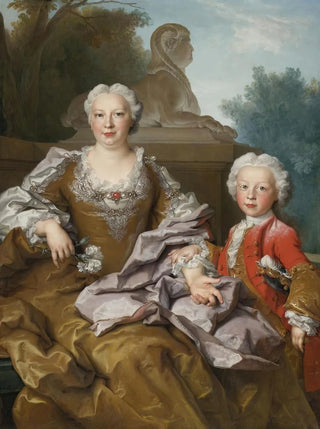Art print | Madame Bertin and her son Balthazar Bruno - Nicolas de Largillière


View from behind

Frame (optional)
The artwork "Madame Bertin and her son Balthazar Bruno" by Nicolas de Largillière, painted in the early 18th century, is an iconic piece that embodies the elegance and sophistication of French society of the time. This portrait, depicting a mother and her son in an intimate moment, transcends the simple family setting to become a true testament to aristocratic lifestyle. Through this work, Largillière does not merely capture faces; he immortalizes emotions, relationships, and an era, offering viewers a privileged glimpse into the daily life of the nobility.
Style and uniqueness of the work
Largillière's style is characterized by fine detail and a vibrant color palette that breathes life into his subjects. In "Madame Bertin and her son Balthazar Bruno," the delicacy of textures—whether the satin of the mother's dress or the velvet of the child's costume—demonstrates exceptional craftsmanship. The composition, where the two figures are placed within a harmonious setting, creates an atmosphere of tenderness and intimacy. The exchanged gazes between Madame Bertin and her son are filled with palpable affection, while the soft light bathing the scene enhances this closeness. Largillière succeeds in transcending the simple portrait to offer a lively scene, where every detail helps tell a story.
The artist and his influence
Nicolas de Largillière, born in 1656, is one of the most renowned portraitists of his time. Trained in the art of painting in Flanders before establishing himself in Paris, he skillfully combined Flemish and French influences to create a unique style that appealed to high society. His portraits, often commissioned by members of the aristocracy, stand out for their ability to capture not only physical appearance but also the personality of his subjects. Largillière played a crucial role in the evolution of portraiture in the 18th century, influencing many artists who followed him. His technique, attention to detail, and understanding of human dynamics made him a

Matte finish

View from behind

Frame (optional)
The artwork "Madame Bertin and her son Balthazar Bruno" by Nicolas de Largillière, painted in the early 18th century, is an iconic piece that embodies the elegance and sophistication of French society of the time. This portrait, depicting a mother and her son in an intimate moment, transcends the simple family setting to become a true testament to aristocratic lifestyle. Through this work, Largillière does not merely capture faces; he immortalizes emotions, relationships, and an era, offering viewers a privileged glimpse into the daily life of the nobility.
Style and uniqueness of the work
Largillière's style is characterized by fine detail and a vibrant color palette that breathes life into his subjects. In "Madame Bertin and her son Balthazar Bruno," the delicacy of textures—whether the satin of the mother's dress or the velvet of the child's costume—demonstrates exceptional craftsmanship. The composition, where the two figures are placed within a harmonious setting, creates an atmosphere of tenderness and intimacy. The exchanged gazes between Madame Bertin and her son are filled with palpable affection, while the soft light bathing the scene enhances this closeness. Largillière succeeds in transcending the simple portrait to offer a lively scene, where every detail helps tell a story.
The artist and his influence
Nicolas de Largillière, born in 1656, is one of the most renowned portraitists of his time. Trained in the art of painting in Flanders before establishing himself in Paris, he skillfully combined Flemish and French influences to create a unique style that appealed to high society. His portraits, often commissioned by members of the aristocracy, stand out for their ability to capture not only physical appearance but also the personality of his subjects. Largillière played a crucial role in the evolution of portraiture in the 18th century, influencing many artists who followed him. His technique, attention to detail, and understanding of human dynamics made him a






